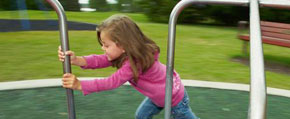We are pleased to announce an exciting new alliance between Active Living Research and GP RED to co-host and coordinate...
Neighborhood Walkability Perceptions: Associations with Amount of Neighborhood-Based Activity by Intensity and Purpose
Presentation at the 2009 Active Living Research Annual Conference
Background:
Increasing evidence indicates that many neighborhood attributes are positively associated with physical activity (PA). However, despite calls for specificity in ecological PA research (Giles-Corti et al., 2005; Saelens & Handy, 2008), most studies of environmental supports examine neighborhood attributes in relation to an aggregated measure of PA that ignores location and other details about that activity. Research in this area would be advanced by a better understanding of where exactly PA occurs and the extent to which neighborhood attributes predict neighborhood-based PA, including the amount, intensity, and purpose of that activity (Giles-Corti et al., 2008).
Objectives:
The purpose of this study was three-fold: i) to describe the proportion of PA episodes that occur within participants’ neighborhoods relative to other locations, ii) to examine how neighborhood walkability attributes are associated with the amount and intensity of PA that occurs specifically within neighborhoods, and iii) to investigate which neighborhood walkability attributes are related to PA engaged in within the neighborhood for the distinct purposes of recreation and transportation.
Methods:
Data were collected in four neighborhoods from 384 randomly-selected residents (60.9% response rate). Participants completed the abbreviated version of the Neighborhood Environment Walkability Survey (NEWS) measuring seven dimensions of neighborhood supports for PA: residential density; land use mix-diversity; land use mix-access; street connectivity; walking/cycling facilities; aesthetics; and safety from traffic and crime (Saelens et al., 2003). Participants also maintained a seven-day PA log booklet in which they recorded the intensity (mild, moderate, or strenuous), purpose (recreation, transportation, household, or job-related), and location for all episodes greater than 10 minutes (validated definitions were provided for all terms). Location descriptions for each episode recorded as open-ended text were coded as i) at home, ii) in the participant’s neighborhood (in whole or in part), or iii) in another location (1.7% of the 3815 episodes could not be classified). Episodes within the neighborhood are of particular interest to this study and were determined on a case-by-case basis using municipally-defined planning boundaries and the described locations or streets where the episode occurred.
Initial descriptive analyses examined the proportion of PA episodes that occurred at home, in the neighborhood, or another location. Participants were then divided into three groups according to their level of weekly neighborhood PA: zero minutes, 1-59 minutes, or 60+ minutes. Multivariate analysis of variance with Scheffe post-hoc tests was used to examine differences in walkability perceptions among the three groups. Three separate models were analyzed for mild, moderate, and strenuous neighborhood PA with the scores for the seven NEWS dimensions as dependent variables. Subsequently, similar analyses were undertaken using two groups (0 minutes vs. 1+ minutes) based on participants’ levels of recreational PA and transportation-related PA within the neighborhood. All analyses controlled for age, gender, and the presence of an injury that might limit the participant’s PA.
Results:
Only one-third (32.9%) of the reported episodes occurred in participants’ neighborhoods, with 28.5% at home, and 38.6% in other contexts (e.g., out of town). Ratings of the seven walkability attributes did not differ between the groups when examining the overall level of mild or strenuous PA within the neighborhood. However, participants engaging in no moderate neighborhood PA (0 min) had significantly lower ratings on five of the attributes (street connectivity, aesthetics, safety, land use-diversity, and land use-access) than those engaging in 1-59 or 60 or more minutes of moderate neighborhood PA (but post-hoc tests also showed no differences between the 1-59 and 60+ groups). For transportation-related neighborhood PA, participants engaging in at least some activity of this type (1+ minutes) reported more positive perceptions of land use mix-access, aesthetics, and street connectivity. For recreational neighborhood PA, only ratings of aesthetics were significantly higher among those engaging in 1 or more minutes.
Conclusions:
Only a portion of total PA occurs in neighborhoods; therefore, the context of activity should be examined when drawing associations with neighborhood environments. In this study, perceptions of neighborhood walkability attributes significantly discriminated between participants who engaged in some versus zero minutes of moderate neighborhood PA, but did not significantly discriminate between two more active groups (1-59 and 60+ min). Thus, a more ‘walkable’ neighborhood may be a trigger for undertaking some PA, but other factors (e.g., self-efficacy, family responsibilities) may better explain the amount of neighborhood PA people engage in. Nevertheless, much research has suggested that the greatest gains in PA promotion may come from stimulating the bulging group of inactive persons to initiate some activity, rather than by convincing already active people to do more. Improving neighborhood walkability may be a stimulus for increased neighborhood PA, especially among largely sedentary individuals, but the present study also shows that different attributes are associated with transportation-related and recreational activity.
Support:
Supported by the National Cancer Institute of Canada via the Sociobehavioural Cancer Research Network and the Centre for Behavioural Research and Program Evaluation.
STAY UP TO DATE
RECENTLY ADDED TOOLS & RESOURCES
MOVE! A BLOG ABOUT ACTIVE LIVING
The "Active Living Conference" aims to break down research and practice silos and...







